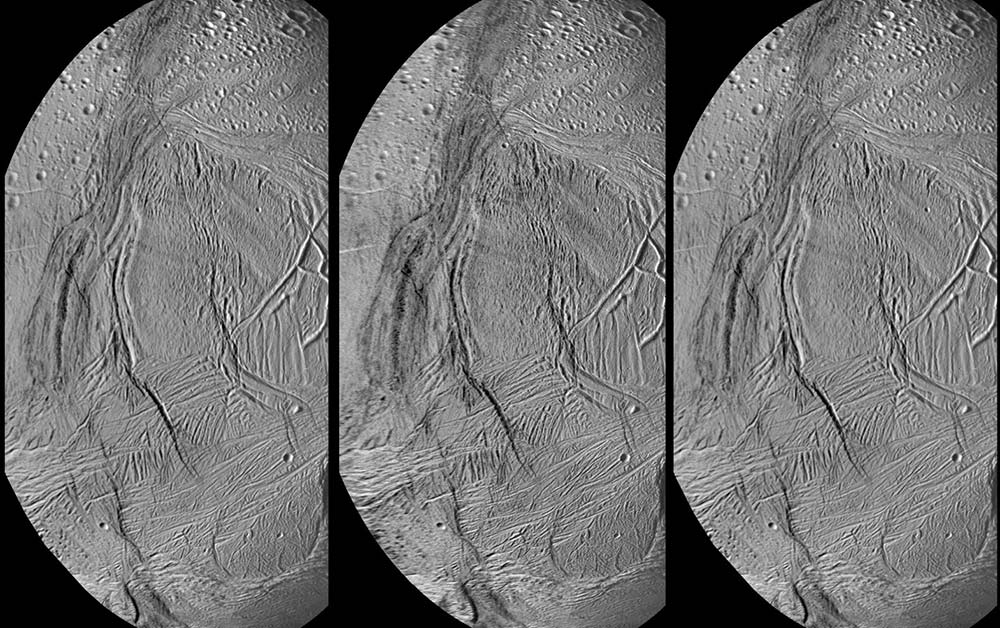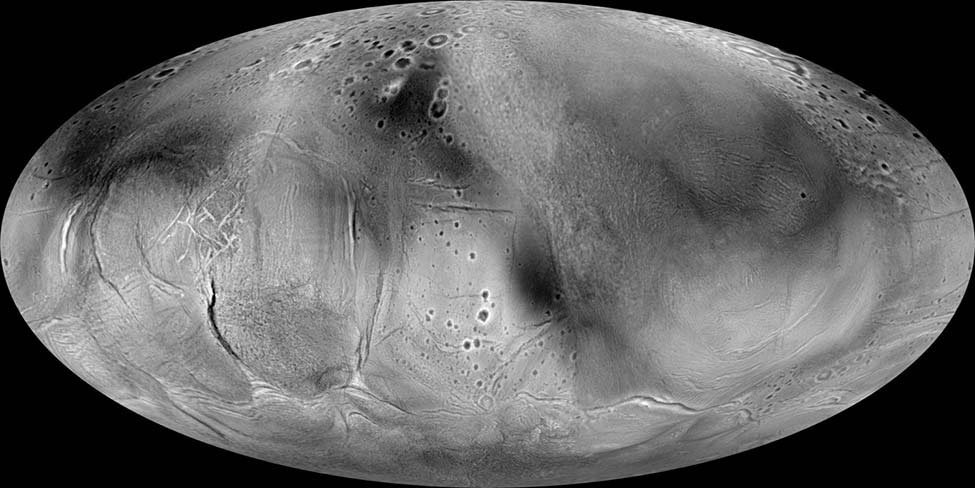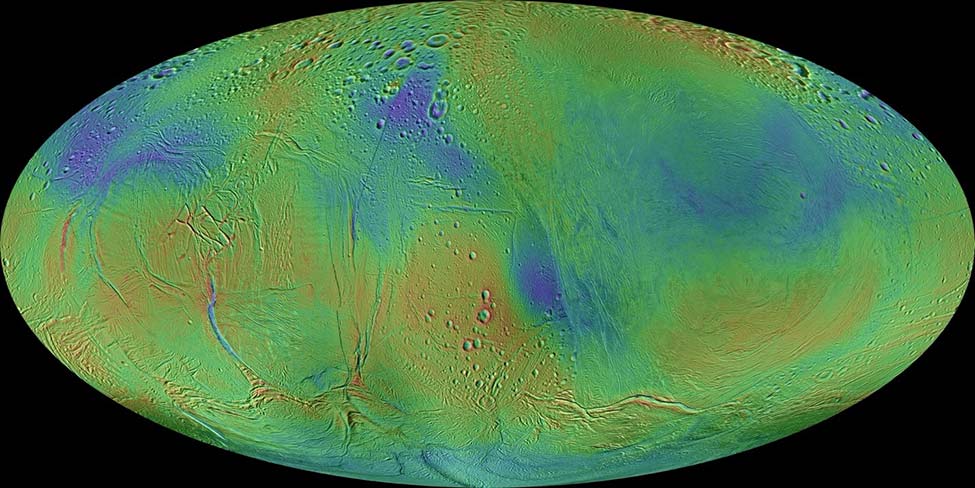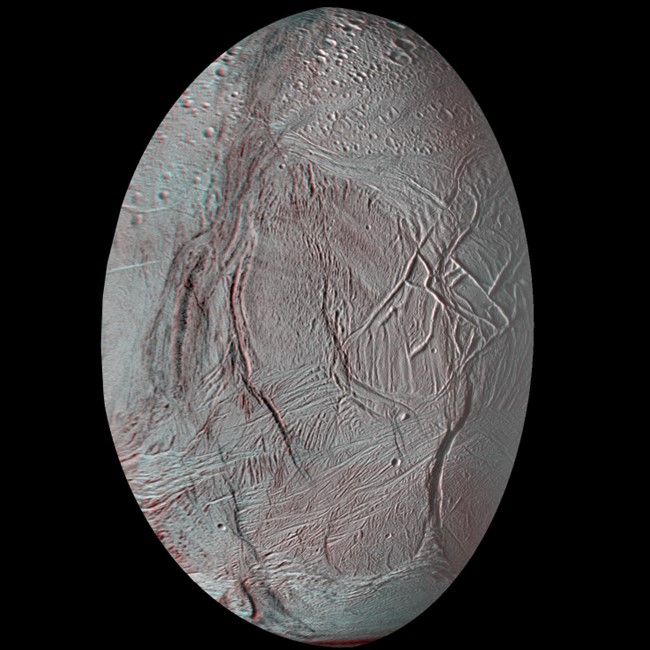Mollweide diagram of the new topography of Enceladus. Colors are used to show the range of terrain where red is high and blue is low. A global triangular image of Enceladus was subtracted to reveal the features shown. Credit: Paul Schenk/USRA-Lunar and Planetary Institute.
A team of scientists has created the first complete and detailed global topographic map of Saturn’s active icy moon Enceladus, revealing that it is much more eroded than previously thought. In an article published in the journal Icarus, Paul M. of the USRA’s Lunar and Planetary Institute. Schenck and William B. of Washington University in St. Louis. MacKinnon and others show that this small ocean world is being degraded by internal processes outside the active regions. Wind at the South Pole.

Stereo image of Enceladus showing cratered landscapes, impact craters, a 1.5-km-high ridge (middle left) and a large deep basin (top left). The resolution of the images is 350 meters/pixel. The images were obtained by reflected light from Saturn. In this format, the scene can be viewed in cross-eyes or wall-eyes stereo (use a center-left or center-right combination). Credit: Paul Schenk/USRA-Lunar and Planetary Institute.
Oval craters 100 kilometers (~62 miles) wide and 1.5 kilometers (~1 mile) deep are prominent features in the new map. In 2009, the authors published a preliminary topographic map of less than half of Enceladus’ surface, showing several depressions. However, their new global complete data revealed that these large oval basins were mostly on one side of Enceladus, and now a large complex depression can be seen on the other hemisphere.


Mollweide diagram of the new topography of Enceladus. Colors are used to show the range of terrain where red is high and blue is low. A global triangular image of Enceladus was subtracted to reveal the features shown. Credit: Paul Schenk/USRA-Lunar and Planetary Institute.
„Some of these basins are simple ovals but others have more complex shapes that correlate with geological features,” says Dr Schenk, lead author of the study and an expert in the topography, surface color and morphology of icy moons. This correlation suggests that the ice floating in Enceladus’ ocean is not uniform in its thickness or properties. „We don’t know the exact origin of these basins, but their global distribution revealed by our new map is similar to the patterns predicted for hydrothermal plumes that could escape from Enceladus’ rocky core,” says Dr Schenk. If true, plumes of warm water floating in Enceladus’ global ocean from such a core could rise and impinge on the ocean ice. Such obstruction may induce thinning of the ice sheet and possibly localized melting, thus directly submerging the surface—creating basins.
„If such hydrothermal activity is indeed happening, we need to return to Enceladus to determine how this strange moon gets rid of its excess heat,” says co-author Dr. William McKinnon of Washington University in St. Louis.
The new topographic map of Enceladus is derived from nearly 100 stereo image pairs of the surface acquired during the NASA Cassini mission, which were used to create topographic maps that were then combined to create a global topographic map product.

Above is a red-blue anaglyph version of a stereo image of Enceladus. Red-blue glasses are required for viewing. Credit: Paul Schenk/USRA-Lunar and Planetary Institute.
The biggest surprise of the new topography map is that Enceladus is deformed in a north-south direction, which is exactly what its shape would be like if it were a pressure-free, perfectly uniform body. Enceladus is observed to be somewhat pear-shaped. It is low in the South Pole, high in mid-south latitudes, low again in mid-north latitudes, and high again in the North Pole. These deformations range from 350 to 400 meters in amplitude. These distortions in the shape of Enceladus provide unique new insights into the current internal dynamics of this ocean world, which will be the subject of future investigation.
For more information, visit https://www.sciencedirect.com/science/article/abs/pii/S0019103523004062
Astronomy

„Oddany rozwiązywacz problemów. Przyjazny hipsterom praktykant bekonu. Miłośnik kawy. Nieuleczalny introwertyk. Student.
